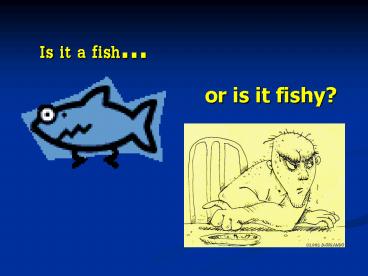Is it a fish - PowerPoint PPT Presentation
1 / 25
Title:
Is it a fish
Description:
When might a cupped disc be something else? ?'? ??? ???? ??????? ... HVF arcuate defects aligned horizontally. Compressive lesions. Younger 50 y. VA 20/40 ... – PowerPoint PPT presentation
Number of Views:40
Avg rating:3.0/5.0
Title: Is it a fish
1
Is it a fish
or is it fishy?
2
ORWhen might a cupped disc be something else?
- ?"? ??? ???? ???????
- ??"? ??? ???? ?????? ?????? ????? - ????
3
Our Patients
4
Frequency
- Up to 15-25 of patients with POAG experience NTG
- In the Baltimore Eye Study
- 50 of individuals with cupping and VF changes
had an IOP lt 21 on a single visit - 33 had an IOP lt 21 mm Hg on 2 measurements
5
NTG and compressive lesions
- Both can cause ONH cupping
- Both can produce VF changes
- Compression of the ON may make the nerve
susceptible to damage at normal Tension
6
Do I need to image?
- Yes Occasional pathology found, Kastach
difficult patients - No Low cost effectiveness, unnecessary
radiation (CT)
7
Compressive lesions to consider in NTG
- Meningiomas
- Craniopharyngiomas
- Pituitary tumors
- Cysts
- Chordomas
- Compression by normal carotid artety
- Aneurysms affecting
- the prechiasmal and/or chiasmal visual pathways.
8
Compression by ICA
- Gutman and Melamed (Graefes 1993) studied by CT
62 patients with NTG - 90 had either calcification or dilation of the
ICA adjacent to the opening of the optic canal - Only 21 of age matched controls had similar
abnormalities
9
N. Ogata - BJO 2005
- Retrospective, 103 eyes with NTG, 104 controls
- Compressive optic neuropathy by ICA in 49.5 of
NTG patients - 34.6 in age matched controls
- Bilateral compression
- 40.7 of NTG
- 21.2 in controls
- C/D gt 0.7 higher frequency of ICA compression
Neurosurgical decompression? dont rush
10
Sheba Hospital (RHB)
- 40 consecutive NTG suspects referred to the
neuro-ophthalmology clinic - Complete neuro-ophthalmic exam
- Review of scans by neuro-ophthalmologist (RHB)and
neuro-radiolosist (MB)
11
Results
12
NTG - Suspected findings
- gt visual complaint
- gt color vision defect
- gt optic disc pallor
- gt atypical visual field defect for glaucoma
13
Greenfield - Oph 1998
- A retrospective case-controlled study
- Fifty-two eyes of 29 NTG patients
- All had brain CT or MRI as part of a diagnostic
evaluation between 1985- 1995 - Comparison group
- 44 eyes of 28 patients withcompressive lesions
and increased C/D ratio
14
RESULTS
- None of the patients diagnosed with glaucoma had
radiologic evidence of a mass lesion in the
anterior visual pathway
15
Group characteristics
- Compressive lesions
- Younger lt50 y
- VA lt 20/40
- No disc hemorrhage
- Mostly pallor
- Vertically aligned defects
- Glaucoma patients
- Older 68.7 y
- Better VA
- Vertical cupping
- Disc hemorrhage (13)
- Less NR pallor
- HVF arcuate defects aligned horizontally
16
CONCLUSIONS
- Anterior visual pathway compression is an
uncommon finding in the neuroimaging of patients
with suspected NTG. - Younger age, lower levels of visual acuity,
vertically aligned visual field defects, and
neuroretinal rim pallor may increase the
likelihood of identifying an intracranial mass
lesion.
17
Ahmed - Methods
- A prospective, comparative, observational case
series, 1988-1998 - 62 consecutive NTG patients had MRI
- 70 progressive POAG with controlled IOP .
- The prevalence of intracranial compressive
lesions, demographic data, and clinical
characteristics were compared. - J Glaucoma, 2002
18
RESULTS
- 4 of the 62 (6.5) patients withNTG had
clinically relevant intracranialcompressive
lesions involving the anterior visual pathway - 2 pituitary macroadenoma, 1 meningioma, 1
arachnoid cyst - None of the 70 patients with POAG had a
compressive lesion (P 0.039)
19
What is the diagnosis?
24-2 HVF of a patient with pituitary macroadenoma
20
What is the diagnosis?
HVF of a patient with an arachnoid cyst
21
CONCLUSIONS
- Intracranial compressive lesions are an important
diagnostic consideration in the workup of
normal-pressure glaucoma - Ahmed Neuroimaging is cost-effective
- Remember
- Compressive lesions can cause cupping and mimic
glaucomatous VF defects!!! - Trobe et al, Arch oph 1980
22
Red Flags
- Mismatch between the cupping and the visual field
loss (C/D 0.5 but 10- VF remaining). - An APD or visual acuity loss out of proportion to
the VF loss or cupping. - Rapid progression of visual loss.
- Glaucomatous-appearing visual field loss in a
patient with an anomalous or hypoplastic optic
nerve (where cupping is hard to judge).
23
Indications for neurological workup
- Unexplained reduction of visual acuity
- Color vision loss w/o advanced VF loss
- visual field loss out of proportion to cupping
- VF loss atypical for glaucoma
- Optic nerve pallor in excess of cupping
- Neurological symptoms.
24
I agree with the authors
- If it looks like normal-tension glaucoma, you do
not have to do neuroimaging - to sleep at night.
- Richard Mills, Discussion on Greenfield
25
(No Transcript)































